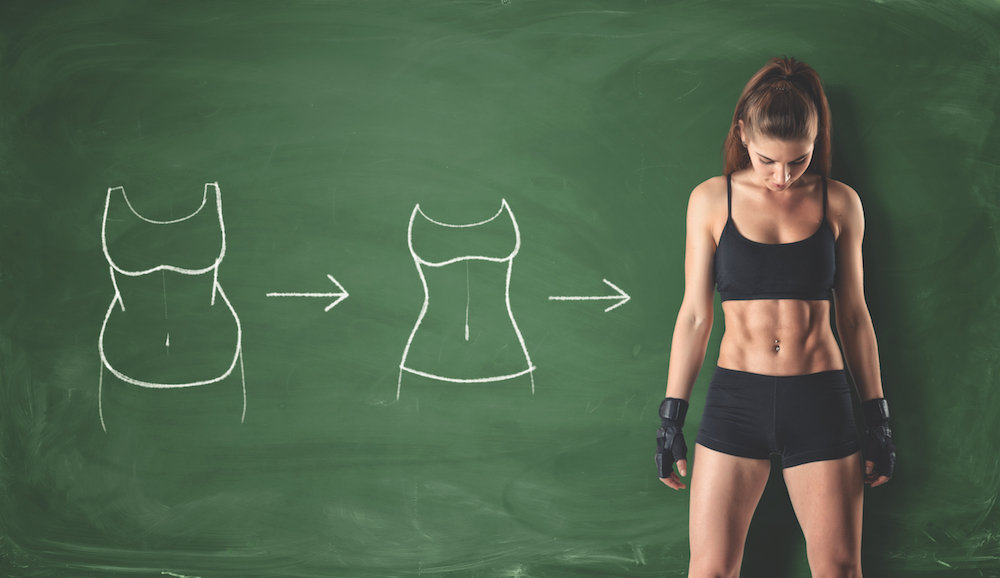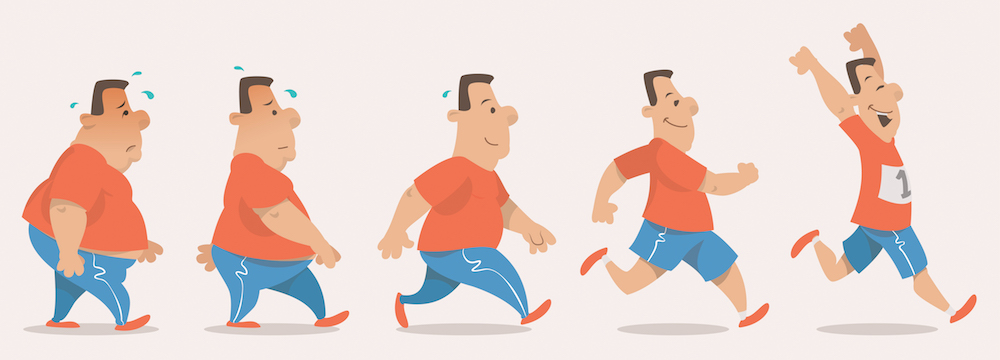

Professing intent to lose a few kilos is a summer rite of passage, regardless of whether or not you need it. Somehow the words ‘family coming from interstate’ and ‘beach vay-cay’ assume validity despite depending on very flawed logic.
But body weight doesn’t do whims. Go too hard too fast last-minute and you stand a good chance of wearing the evidence for years to come. The brain has powerful ways of defending the body weight that is its target. The brain’s weight-regulation system has two simple priorities: body weight should remain stable and should not decrease too much.
Dip below its liking and it will put its considerable metabolic force into restoring the balance. But while the brain lights to restore any lost weight, it’s more than happy to embrace a slight increase, followed by another slight increase, and so on, by which time you’re so despondent you’re going back for thirds.
So the set point of weight that our body defends easily increases (and, depressingly, does so naturally – ever so gradually – as we age), but is very difficult to peg back once you have scaled the post-diet heights.
Deliberate attempts to become thinner strongly predict weight gain over the long term, even when researchers take initial weight, diet, and exercise habits into account. So starving yourself to squeeze into that special dress for your reunion may work for a three-week timeframe, but what’s the payback? And how will you be looking, and feeling, for your 20-year anniversary?
It all starts with such noble aspirations, positive affirmations and near certainty of success. The launch of your new diet is going to change your world. And it does, not in the first week, but by the third to eight week mark you’re showing some reward for effort. Not quite as much as the testimonials claim, but it’s something.
Then the doubts start to creep in, the cravings increase and you start wondering if cutting out all the good stuff is really going to cut it. Your partner and friends don’t seem to notice and it’s not bringing you the lasting happiness you thought was at the end of the battle. Before you realise it you’ve started to become more obsessed with the negative aspects of the diet than the positive ones. You resent the diet for making you unhappy, and you’re running solely on your disintegrating willpower.

Willpower is a great short-term skill; it’s a great skill to have when dealing with things like study and work, or when playing competitive sport. But eating and drinking are not things we do in the short term. At the most basic level, eating and drinking are driven by our basic hunger and thirst instincts. If we try to ght nature, we will eventually lose and become exhausted in the process. Perversely, rebelling against the diet often provides us with more pleasure than sticking to it. Substantial weight loss increases not only hunger but also the rewards of eating. A hormone called leptin, which is produced by fat cells and travels in the blood to the brain, tells the hypothalamus how much stored energy is available. Leptin also acts directly on the ventral tegmental area (responsible for making sure dopamine gets to important reward centres of the brain) to reduce the reward value of food, making eating less attractive to people when they have adequate fat stores. But as weight loss reduces fat stores and thus leptin levels, eating becomes more rewarding. In fact, when people who’ve lost weight see a picture of a food they desire, the brain shows more activity in reward-related areas than if they hadn’t dieted in the first place.
Crash diets don’t only increase appetite, but they can also cause metabolism to nosedive. As you lose weight, your body switches on its ‘famine response’, slowing its metabolic rate in order to conserve energy and fat stores. When you inevitably regain the weight (it is a case of when, not if), your metabolism may also increase, but it may be comfortable at its new pace. If your weight is yo-yo-ing, your metabolism may be stuck in first gear.
This means that when you do inevitably relent and eat the (whole block of) chocolate, it’s more likely to be stored as fat than if you’d carried on your merry food truck- frequenting way.
Losing weight rapidly can also have a particularly nasty effect on muscle mass. The amount of muscle in the body is directly proportional to metabolic rate, so a loss of muscle inevitably means the loss of metabolic rate.
If you lose weight too fast you’re likely to lose a quarter to a third of your weight loss as muscle, and that directly compromises your metabolic rate. If, for example, you drop 15 kgs really fast, you could lose five kgs of muscle – that’s the equivalent of five kilos of body fat you’re not burning up anymore. Of course you want a fast result, but you should never lose more than a kilo a week, with a much better target being a maximum of 0.5 kg a week, which will ensure that more of your lost weight is fat rather than muscle.
Crash dieting does more than wreak havoc on your waistline; it can seriously mess with your head. You’ve invested so much of your positive willpower that by the time it all crumbles into a messy heap, you have precious left in order to pick yourself up from the kitchen oor and stride purposefully into your day, which is precisely what you need to do. Unfortunately, when most of us pick ourselves up, it’s in order to go to the fridge and pantry. The brain is literally wired to ensure that we repeat behaviours that make us feel good by associating them with the sweet release of dopamine and speci c brain patterning. The brain records a pleasurable action as a beneficial pattern that needs to be remembered and repeated automatically. The smoker lights up a cigarette, for instance, and the food addict opens a bag of potato chips with no regard for long-term risks.
That is until they roll off the couch and start to fear the consequences of those 20 mindless minutes.
So is it futile to deny a food craving or caving into its seductive allure and inevitable weight gain?

Enter protein and thermogenesis. Essentially, thermogenesis is the heat generated by the body during the processes of digestion and metabolism. When we eat protein it is broken down into constituents called ‘amino acids’, which can then be reassembled to form protein. It has been estimated that when amino acids are converted to protein and then back again into amino acids, more than a quarter of the energy originally contained in the amino acids is lost, including as heat. Carbohydrate and fat can also ‘cycle’ in this way, but the energy dissipated is much less than with protein.
Too little protein in your diet can make weight loss extremely difficult. There’s emerging evidence that if you do under-eat protein you’re going to overeat carbohydrates and fat. That’s because protein is more satiating than the other macronutrients.
On the other hand, too much protein can be harmful. Protein becomes toxic when you go above 35% of your kilojoules, even with bodywork, although a lot of hardcore bodybuilders push the threshold with protein shakes and bars. Unfortunately, the proven way to lose weight and keep it off is neither sexy nor novel. All you have to do is eat lots of low-glycaemic plant foods such as greens, cauliflower, tomatoes, aubergine, mushroom, beans, seeds, and nuts. Such low-glycaemic plant foods digest slowly and feed the body with protective nutrients. Consuming foods that take a long time to digest is the key to resensitizing the body to leptin and insulin.
Lucky for us, foods that take a long time to digest contain phytochemicals and angiogenesis- inhibiting effects. When you eat foods that can slowly feed your metabolism without stimulating insulin receptors, you can hormonally activate your weight loss.
Put your money where your mind wants to go and let your body do the appreciating. In other words, spend more on quality produce and you’re more likely to eat less. Then, when you sit down to your glorious meal, turn the TV off and enjoy it with all your senses. Remaining in the present allows you to relax, mentally and physically, and stop the reactive cycle that leads to overeating (or choosing high-sugar or high-fat foods). Being present also keeps you in touch with what’s happening in your body – notably, signals of hunger and fullness that are very easy to ignore when your mind’s going a mile a minute.
Non-exercise activity thermogenesis, or NEAT, covers all movement that isn’t exercise related, including fidgeting, typing, drumming your fingers on the table or jiggling your feet. According to studies from the Mayo Clinic, such activities can signi cantly alter metabolism and may even be more effective than moderate exercise when it comes to burning kilojoules. Researchers now differentiate between non-exercise activity thermogenesis (NEAT), much of which is under conscious control (walking, washing floors) and spontaneous physical activity (SPA), which is beyond awareness (fidgeting, or even tossing and turning at night while sleeping).
If you’re aiming for quickish results, exercise that works out your muscles should be your prime objective. It provides the best bang-for-buck that will not only fast-track you towards a healthy body but also give you the toned features that can give you the appearance of being slimmer. This is because resistance training – using free-weights or resistance machines – fires up your internal furnace, which will continue to burn fat long after you’ve walked away from the gym and are lying on the couch. In fact, studies have found that after an intensive resistance workout, your fat-burn may continue for as much as 34 to 48 hours. Now that’s reward for effort.

Importantly, a resistance session doesn’t take that long either. You will have arrived and left the gym while the jogger is still plugging away on the treadmill. You may have been told that exercising at a comfortable pace is best for fat loss because you are working in the ‘fat-burning zone’. This is just plain wrong. People who say this are confused by the fact that training at low intensities causes the body to use more fat than glycogen for fuel while you are exercising. But what they don’t realise is that high-intensity exercise causes more fat to be burned in total when you take account of afterburn. Plus, with this type of training, the next time you eat, the calories from your food will be used to replace the glycogen you used up rather than stored as fat.